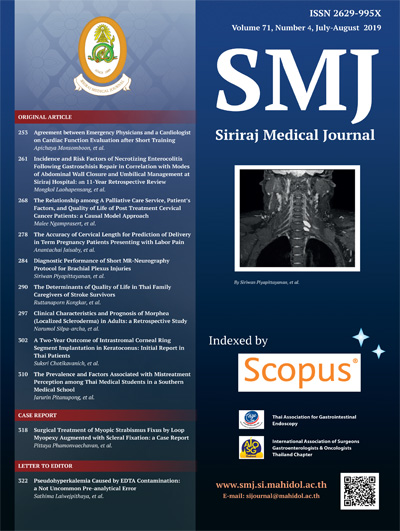The Accuracy of Cervical Length for Prediction of Delivery in Term Pregnancy Patients Presenting with Labor Pain
Keywords:
Cervical length; term gestation; laborAbstract
Objective: To investigate the relationship between cervical length (CL) at gestational age (GA) 37 to 41+6 weeks and delivery within 7 days in term pregnancy patients who presented with labor pain.
Methods: Term pregnancy subjects who attended antenatal clinic and delivered at Bhumibol Adulyadej Hospital, between September 2017 and June 2018 were recruited in this study. Participants who met the inclusion criteria received transvaginal ultrasound to measure CL. Clinical and delivery outcomes were followed. Sensitivity,
specificity, negative predictive value (NPV) positive predictive value (PPV) and accuracy were calculated to assess the relationship between CL and delivery within 7 days.
Results: A total of 106 pregnant women were included in the analysis. The mean age was 26 years. Three-quarters of the cases were nulliparous. The average gestational age at delivery and newborn birth weight were 39 complete weeks and 3,100 grams, respectively. Seventy-six cases successfully delivered within 7 days while 30 patients had to wait for more than 7 days before delivery. The receiver operating characteristic (ROC) curve was used to assess the optimal cutoff of CL. The CL less than 25 mm. gave sensitivity and specificity at 69% and 73%, respectively and gave accuracy of 70.75% in prediction of delivery within 7 days.
Conclusion: Transvaginal CL measurement was useful to predict the time of spontaneous delivery and help clinicians to advise the patients about their delivery plans.
Downloads
Published
How to Cite
Issue
Section
License
Authors who publish with this journal agree to the following conditions:
Copyright Transfer
In submitting a manuscript, the authors acknowledge that the work will become the copyrighted property of Siriraj Medical Journal upon publication.
License
Articles are licensed under a Creative Commons Attribution-NonCommercial-NoDerivatives 4.0 International License (CC BY-NC-ND 4.0). This license allows for the sharing of the work for non-commercial purposes with proper attribution to the authors and the journal. However, it does not permit modifications or the creation of derivative works.
Sharing and Access
Authors are encouraged to share their article on their personal or institutional websites and through other non-commercial platforms. Doing so can increase readership and citations.











